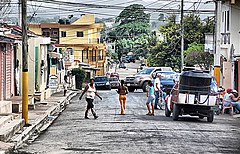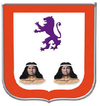Salvaleón de Higüey
 | |||
| |||
| Dewiza: La Villa Bendita | |||
| Państwo | |||
|---|---|---|---|
| Prowincja | La Altagracia | ||
| Data założenia | 1503 | ||
| Powierzchnia | 1.704.59 km² | ||
| Wysokość | 106 m n.p.m. | ||
| Populacja (2012) • liczba ludności • gęstość |
| ||
| Nr kierunkowy | +1 (809), (829), (849) | ||
| Podział miasta | 3 dzielnice | ||
| Strona internetowa | |||
Salvaleón de Higüey znane również jako Higüey – miasto we wschodniej Dominikanie nad rzeką Yuma. Ludność: 189 tys. (2012). Ośrodek administracyjny prowincji La Altagracia.
Rejon został odkryty w 1494 roku przez Juana de Esquivela, a miasto założone w 1503 roku na rozkaz Nicolasa de Ovando. Higüey to główny ośrodek pielgrzymkowy kraju, miejsce kultu maryjnego patronki Dominikany – Matki Bożej z Altagracia (Nuestra Señora de la Altagracia). W latach 50. XX wieku powstała nowa betonowa katedra o nowoczesnym wyglądzie, którą zaprojektowali francuscy architekci André Dunoyer de Segonzac i Pierre Dupré, która szybko stała się najbardziej znanym zabytkiem miasta, a zarazem największym kościołem w kraju[2][3].
Oprócz Bazyliki Nuestra Señora de la Altagracia, znajduje się kościół San Dioniso z 1567 roku. Oprócz tego istnieje też kilka zborów protestanckich i Świadków Jehowy[4].
Z miasta pochodzi zespół muzyczny „Los Hermanos Rosario”.
Przypisy
- ↑ Dane statystyczne. World Gazetteer. [dostęp 2012-01-08]. [zarchiwizowane z tego adresu (2013-04-28)].
- ↑ Christopher P. Baker: Przewodnik National Geographic Dominikana. Wydawnictwo G+J RBA Sp. z o.o.&Co. Sp. Kom., 2013, s. 103. ISBN 978-83-7596-445-5.
- ↑ Przewodnik po Republice Dominikańskiej. la cotica/Ministerstwo Turystyki Republiki Dominikany. s. 118-126, 127.
- ↑ Dane według wyszukiwarki zborów, na oficjalnej stronie Świadków Jehowy jw.org [dostęp 2015-11-15].
Media użyte na tej stronie
The flag of the Dominican Republic has a centered white cross that extends to the edges. This emblem is similar to the flag design and shows a bible, a cross of gold and 6 Dominican flags. There are branches of olive and palm around the shield and above on the ribbon is the motto "Dios,Patria!, Libertad" ("God, Country, Freedom") and to amiable freedom. The blue is said to stand for liberty, red for the fire and blood of the independence struggle and the white cross symbolized that God has not forgotten his people. "Republica Dominicana". The Dominican flag was designed by Juan Pablo Duarte, father of the national Independence of Dominican Republic. The first dominican flag was sewn by a young lady named Concepción Bona, who lived across the street of El Baluarte, monument where the patriots gathered to fight for the independence, the night of February 27th, 1844. Concepción Bona was helped by her first cousin María de Jesús Pina.
Autor: Andreas Volkmer, Licencja: CC BY 2.5
Die Basilika Nuestra de la Altagracia von Higüey in der Dominikanischen Republik
Autor: Mario Rubio, Licencja: CC BY 2.0
Paisaje urbano de Higuey, localidad de la República Dominicana.
Autor: Alexrk2, Licencja: CC BY-SA 3.0
Location map Dominican Republic with Provinces, Equirectangular projection, N/S stretching 105 %. Geographic limits of the map:
Escudo Ayuntamiento Higuey







